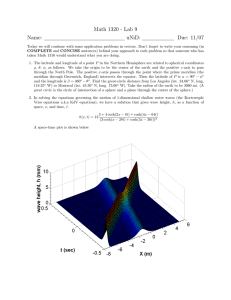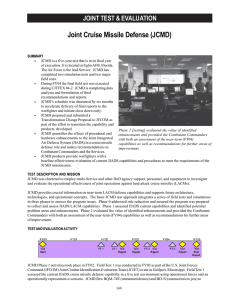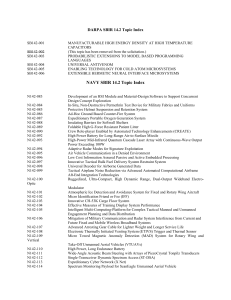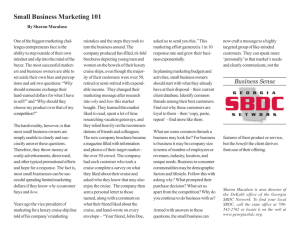U.S. DOD Form dod-opnavinst-3600-3a
advertisement
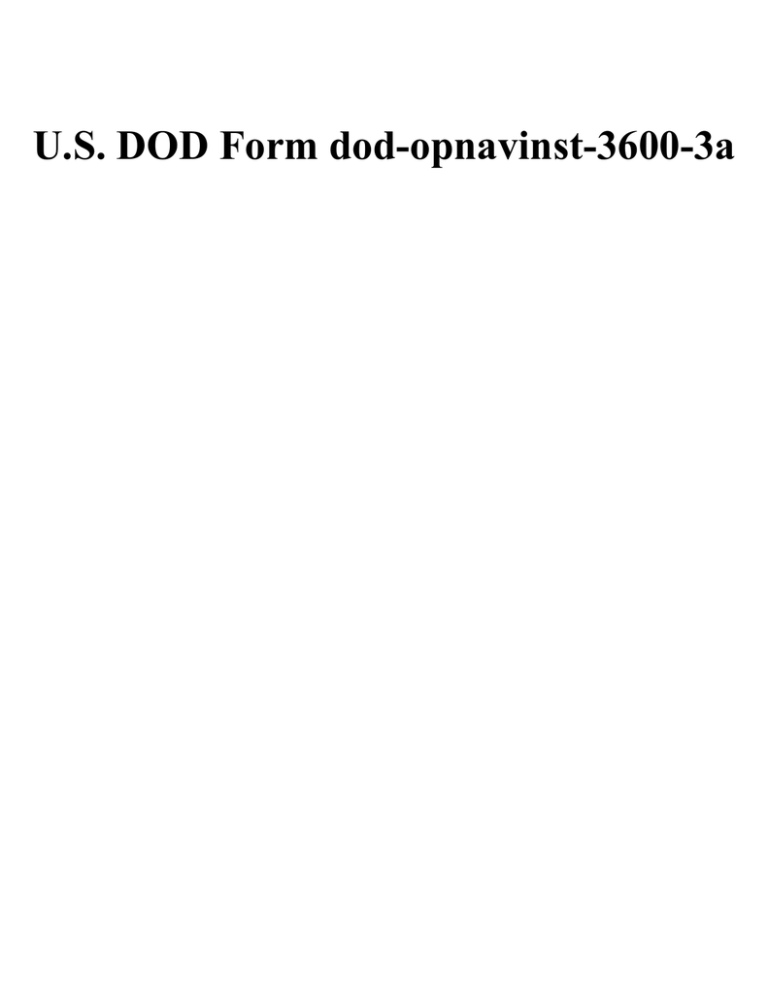
U.S. DOD Form dod-opnavinst-3600-3a DEPARTMENT OFFICE OF THE CHIEF WASHINGTON, OF THE OF NAVAL DC 20350-2000 NAVY OPERATIONS IN REPLY REFER TO OPNAVINST 3600.3A N865F 2 December 1992 — OPNAV INSTRUCTION 3600.3A From: Chief of Naval Operations Subj : POLICY FOR THE MATERIAL AND TACTICAL CERTIFICATION OF CRUISE MISSILE CAPABLE SURFACE SHIPS AND SUBMARINES Encl: (1) Cruise Missile Certification Guidelines Purpose. To establish the policy for certification and 1. tactical qualifications of cruise missile capable surface ships and submarines for safe operation, maintenance and tactical employment of cruise missiles. 2. — Cancellation. OPNAVINST 3600.3. (R 3. Background. Cruise missiles provide a wide range of tactical Technological advances and capability employment applications. improvements continually broaden the complexity of cruise missile system maintenance, operation and employment. The trend toward increased warfighting emphasis on cruise missiles dictates the need to establish and maintain a standard process to train and qualify shipboard personnel, and to verify the crew’s understanding of cruise missile systems and their tactical employment. (R 4. Discussion. The cruise missile certification process contains two distinct components, i.e. , material certification Cruise missile and cruise missile tactical qualification. capable ships and submarines must attain material certification prior to onloading conventional missiles. Material certification validates system integrity, including certifying the system is safe to load missiles, and evaluates the crew’s ability to safely maintain equipment. Inherent in the material certification process is a verification that proper tools, documentation, maintenance procedures, test equipment and system level of knowledge are adequate to support system operation. Material certification is conducted under the auspices of PEO(CU) and NAVSEA. Additionally, cruise missile capable ships and submarines must demonstrate minimum tactical proficiency skills necessary to support tactical employment in a variety of scenarios. Tactical proficiency qualification standards are the exclusive province of the Fleet CINCS but, as a minimum, must include the specific requirements contained in enclosure (1). Nuclear weapons capabilities will be verified through the Nuclear Weapon Technical Inspection (NWTI) process. (R IIIIIIIIIIIIIIIIIIIIIIIIIII 0 !5‘Y‘7L“D 0 3 (!)1 4 0 0 LGaL OPNAVINST 3600.3A j!DEC 1992 5. Policv (R a. Completion of the cruise missile certification process is required for all TOMAHAWK and HARPOON capable surface ships and submarines. b. The certification process for surface ships and submarines will be common to both fleets. Certifications are valid for all theaters of operation. c. Cruise missile capable ships must attain material certification prior to loading cruise missiles. (1) Material certification occurs after new construction or initial system installation and includes the material certification requirements contained in enclosure (1). (2) Material recertification is required following a Regular Over-Haul (ROH) 180 days or longer, when significant upgrades/changes are made to the system, and when deemed necessary by the governing technical agencies or Type Commanders. d. A tactical employment proficiency qualification process, as determined by the Type Commander, shall be completed after completion of the material certification and prior to undertaking tasking to launch or employ cruise missiles. This includes post ship delivery trial firings of HARPOON, TASM, and TLAM missiles. Periodic demonstration of tactical proficiency shall be as determined by the Type Commander. 6. Action (R a. Following initial certification or subsequent recertification, the appropriate technical agency shall certify to the Type Commander that the TOMAHAWK/HARPOON weapon system material readiness is satisfactory and the system is safe to load missiles. b. Type Commanders will establish programs to certify crews to handle and tactically employ cruise missiles. These programs will include a periodic recertification process to ensure proficiency is maintained as a continuum of readiness. The minimum elements of the Type Commander tactical qualification process are contained in enclosure (l). 2 . —- .—— . OPNAVINST 3600.3A 2 DEC 1992 c. Requisite training to support the material certification and tactical qualification processes shall be determined by the governing technical agencies and Chief of Naval Education and Training, and be incorporated into all appropriate courses of instruction. Distribution: SNDL 21A (Fleet Commander in Chief) (Fleet Commanders) 22A 23A1 (Naval Force Commander LANT) 23A2 (Naval Force Commander PAC) (Fleet Training Commands) 24H 26G (FBM Operational Test Support Unit) (Fleet Training Groups) 26H (Cruiser-Destroyer Group) 28B — (Destroyer Squadron) (Submarine Group and Squadron) (Patrol Combatant Missile (Hydrofoil) Squadron) (Guided Missile Cruiser (CG)(CGN)) (Destroyer (DD) 963 Class) (Guided Missile Destroyer (DDG)) (Submarine (SSN)) (Fleet Ballistic Missile Submarine (SSBN)) (Guided Missile Frigate (FFG)) (Patrol Combatant Missile (Hydrofoil) (PHM)) (Submarine Tender (AS)) (Auxiliary Floating Dry Dock (AFDB) (AFDL) (AFDM) and Auxiliary Repair Dry Dock (ARD) (ARDM)) FKAIA (Air Systems Command Headquarters) FKAIG (Sea Systems Command Headquarters) C25A (OPNAV Support Activity Detachment) (Fort Ritchie only) 28D 28K 28M 29A 29E 29F 29N 29Q 29AA 29DD 32DD 36A Chief of Naval Operations (N86, N87) (10 copies each) SECNAV/OPNAV Directives Control Office, Washington Navy Yard, Bldg 200, Washington, D.C. 20374-5074 (30 copies) Stocked: Naval Aviation Supply Office Physical Distribution Division Code 103 5801 Tabor Avenue (100 copies) Philadelphia PA 19129-5099 3 OPNAVINST 3600.3A z OEC 1992 (R Cruise Missile Certification Guidelines The following areas will be inspected, as a minimum, during the process of cruise missile certification. a. Material Certification: (1) Inspect the complete weapon system installation, including safety and security devices. (2) Conduct system material checks to ascertain the state of material readiness and that the system is safe to load missiles. (3) Evaluate in-place integrated logistics support, including onboard repair part inventory. (4) Inventory required tools, maintenance documentation and test equipment. (5) Evaluate crew’s ability to properly power-up equipment and conduct procedural checks to verify system performance. b. Tactical Qualification: (1) Evaluate the adequacy of crew manning, formal schools and shipboard training to support cruise missile employment. (2) Evaluate the crew’s knowledge and use of tactical doctrine for all cruise missile systems. (3) Witness and evaluate the crew’s ability to correlate and use Over the Horizon (OTH) data inputs for mission planning and cruise missile employment. (4) Examine and evaluate the crew’s proficiency in operating cruise missile system components. (5) Witness and evaluate casualty response involving the missile and fire control system operation. (6) Exercise and examine command and control operating procedures regarding the release and execution of cruise missile firings. Enclosure -1-.”—--- .-.-a -k:-. (1)
